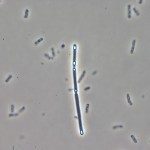Link to Pubmed [PMID] – 11988529
Microbiology (Reading, Engl.) 2002 May;148(Pt 5):1543-51
The effect of detrimental conditions on bacterial motility in Escherichia coli was investigated. Expression profiling of mutant E. coli strains by DNA arrays and analysis of phenotypic traits demonstrated that motility and low-pH resistance are coordinately regulated. Analysis of transcriptional fusions suggests that bacterial motility in response to an acidic environment is mediated via the control by H-NS of flhDC expression. Moreover, the results suggested that the presence of an extended mRNA 5′ end and DNA topology are required in this process. Finally, the presence of a similar regulatory region in several Gram-negative bacteria implies that this mechanism is largely conserved.


